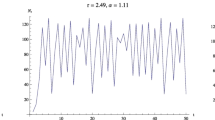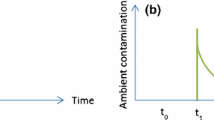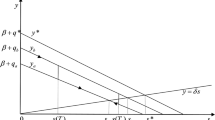Abstract
Most formal optimal pollution control models in environmental economics assume a constant natural assimilative capacity, despite the biophysical evidence on feedback effects that can degrade this environmental function, as is the case with the reduction of ocean carbon sinks in the context of climate change. The few models that do consider this degradation establish a bijective relation between the pollution stock and the assimilative capacity, thus ignoring the inertia mechanism at stake. Indeed the level of assimilative capacity is not solely determined by the current pollution stock but also by the history of this stock and by the length of time the ecosystem remains above the degradation threshold. We propose an inertia assessment tool that tests the sustainability of any benchmark optimal pollution path when the inertia of the assimilative capacity degradation process is taken into account. Our simulations show a strong sensitivity to both the inertia degradation speed and the discount rate, thus stressing the need for increased monitoring of natural assimilative capacity in environmental policies.







Similar content being viewed by others
Notes
The assimilative function A(Z) is a bijective function of the pollution stock Z.
The implication that environmental damages may be compensated, totally or up to a point, by higher consumption can raise both social and environmental concerns with respect to the resulting policy. Although this compensation can make sense from a social planner’s perspective, it may hide inequalities if the agents actually suffering from the environmental damage are not the same as those who enjoy the economic benefits of pollution. In addition, it can be argued that when environmental damage causes irreversible degradation in natural capital (major biodiversity loss for instance), no compensation should be allowed to take place.
An economic intuition often claimed to explain this relation is that the assimilative capacity level can be interpreted as a component of the discount rate, hence the higher α0 the higher Zss.
It must be noted that irreversibility is present once the pollution stock reaches Zc since it is then impossible to reduce the pollution stock with a zero assimilative capacity and no external restoration.
Our model displays similarities with [22] as we share the same inspirations in the literature. However, we do not abide by their strong assumptions on assimilative capacity restoration that make their model less relevant in tackling the crucial case of GHG.
It must be noted that we have modified the notations of the authors to make them fit the ones we used so far and that here the inverted U-shape function refers to the total absolute assimilative capacity α(t) ∗ Z(t), not to the image function α(Z(t)).
Variables with no superscript refer to the variables in the system with inertia while variables with a ∗ superscript refer to the variables obtained in the benchmark model without assimilative capacity degradation.
References
Keeler, E., Spence, M., Zeckhauser, R. (1972). The optimal control of pollution. Journal of Economic Theory, 4, 19–34.
Plourde, C.G. (1972). A model of waste accumulation and disposal. The Canadian Journal of Economics, 5 (1), 119–125.
Schuster, U., & Watson, A. (2007). A variable and decreasing sink for atmospheric CO2 in the North Atlantic. Journal of Geophysical Research, C11006, 112.
Le Quéré, C., Radenbeck, C., Buitenhuis, E.T., Conway, T.J., Langenfelds, R., Gomez, A., Labuschagne, C., Ramonet, M., Nakazawa, T., Metzl, N., Gillett, N., Heimann, M. (2007). Saturation of the Southern Ocean CO2 sink due to recent climate change. Science, 316(5832), 1735–1738.
International Climate Change Taskforce. (2005). Meeting the climate challenge : recommandations of the International Climate Change Taskforce.
Plattner, G.-K., Joos, F., Stocker, T., Marchal, O. (2007). Feedback mechanisms and sensitivities of ocean carbon uptake under global warming. Tellus, 53B, 564–592.
Heinze, C., Meyer, S., Goris, N., Anderson, L., Steinfeldt, R., Chang, N., Le Quéré, C., Bakker, D.C.E. (2015). The ocean carbon sink - impacts, vulnerabilities and challenges. Earth System Dynamics, 6, 327–358.
Watson, A.J., Schuster, U., Bakker, D.C.E., Bates, N.R., Corbière, A., González-Dávila, M., Friedrich, T., Hauck, J., Heinze, C., Johannessen, T., Körtzinger, A., Metzl, N., Olafsson, J., Olsen, A., Oschlies, A., Padin, X.A., Pfeil, B., Santana-Casiano, J.M., Steinhoff, T., Telszewski, M., Rios, A.F., Wallace, D.W.R., Wanninkhof, R. (2009). Tracking the variable North Atlantic sink for atmospheric CO2. Science, 326, 1391–1393.
Schuster, U., Watson, A.J., Bates, N.R., Corbière, A., Gonzalez-Davila, M., Metzl, N., Pierrot, D., Santana-Casiano, M. (2009). Trends in North Atlantic sea-surface CO2 from 1990 to 2006. Deep-Sea Res. Pt. II, 56, 620–629.
Forster, B. (1975). Optimal pollution control with a nonconstant exponential rate of decay. Journal of Environmental Economics and Management, 2, 1–6.
Tahvonen, O., & Salo, S. (1996). Nonconvexities in optimal pollution accumulation. Journal of Environmental Economics and Management, 31, 160–177.
Toman, M.A., & Withagen, C. (2000). Accumulative pollution, clean technology and policy design. Resource and Energy Economics, 22, 367–384.
Tahvonen, O., & Withagen, C. (1996). Optimality of irreversible pollution accumulation. Journal of Economic Dynamics and Control, 20, 1775–1795.
Hediger, W. (2009). Sustainable development with stock pollution. Environment and Development Economics, 14(6), 759–780.
Krawczyk, J.B., & Serea, O.-S. (2013). When can it be not optimal to adopt a new technology? A viability theory solution to a two-stage optimal control problem of new technology adoption. Optimal Control Applications and Methods, 34(2), 127–144.
Perman, R., Ma, Y., McGilvray, J. (1996). Natural resource and environmental economics. London: Longman.
Forster, B. (1973). Optimal consumption planning in a polluted environment. Economic Record, 49(4), 534–545.
Holling, C. (1973). Resilience and stability of ecological systems. Annual Review of Ecology and Systematics, 4, 1–23.
Hanson, G.C., Groffman, P.M., Gold, A.J. (1994). Symptoms of nitrogen saturation in a riparian wetland. Ecological Applications, 4, 750–756.
Prieur, F. (2009). The environmental Kuznets curve in a world of irreversibility. Economic Theory, 40(1), 57–90.
Leandri, M. (2009). The shadow price of assimilative capacity in optimal flow pollution control. Ecological Economics, 68(4), 1020–1031.
El Ouardighi, F., Benchekroun, H., Grass, D. (2014). Controlling pollution and environmental absorption capacity. Annals of Operations Research, 220(1), 111–133.
Pearce, D.W. (1976). The limits of cost-benefit analysis as a guide to environmental policy. Kyklos, 29(1), 97–112.
Pezzey, J.C.V. (1996). An analysis of scientific and economic studies of pollution assimilation. Working Paper 1996/7, Center for Resource and Environmental Studies, the Australian National University.
Godard, O. (2006). La pensée économique face à l’environnement. In Leroux, A. (Ed.) leçons de Philosophie Economique - Volume 2 : Economie normative et philosophie morale, Paris, Economica (pp. 241–277).
Cesar, H., & de Zeeuw, A. (1994). Sustainability and the greenhouse effect: robustness analysis of the assimilation function. In Carraro, C., & Filar, J. (Eds.) Control and game theoretical models of the environment (pp. 25–45). Birkhäuser: Boston.
Martinet, V., & Doyen, L. (2007). Sustainability of an economy with an exhaustible resource: a viable control approach. Resource and Energy Economics, 29(1), 17–39.
Schubert, K. (2008). La valeur du carbone : niveau initial et profil temporel optimaux. In Quinet, A. (Ed.) La valeur tutélaire du carbone. Centre d’Analyse Stratégique, 2 (pp. 195–210).
Acknowledgements
The authors are grateful to the FAERE Working Papers anonymous referee for stimulating comments. We also thank the participants of the 2016 EAERE and 2016 FAERE conference for their feedback. All remaining errors are ours. Marc Leandri is thankful to INRA-LAMETA for the research fellowship that permitted him to initiate this research. The authors are grateful to the anonymous referees and to the editor and advisory editor for their stimulating and helpful comments.
Funding
This work was supported by the ANR GREEN-Econ research project (ANR-16-CE03-0005) and the ANR-10-LabX-11-01.
Author information
Authors and Affiliations
Corresponding author
Appendix
Appendix
1.1 A.1 The Benchmark Model
Let us solve the benchmark optimal pollution control problem with constant assimilative capacity:
with the standard properties: f, the concave benefit function from pollution; D, the environmental damage function (increasing and convex); ρ, the discount rate; Z0, the initial pollution stock; and α0 the constant assimilative capacity (0 < α0)
We thus get the following Hamiltonian with λ the co-state variable associated to Z
which yields the standard first-order conditions
1.1.1 A.1.1 Benchmark Steady State
Given the dynamics of Z and λ and the properties of f and D, a unique Zss exists such that
Let us introduce the standard functional forms commonly found in the literature that we will use for further calculations and that respect the basic properties required:
With these functional forms, Eq. 17 is tantamount to
1.1.2 A.1.2 Characterization of the Optimal Path
We can determine analytically the expression of Z∗(t), λ∗(t) and y∗(t) along the optimal pollution path by solving the first-order conditions (15), (16) for the quadratic linear functional forms.
where \( \bar {\rho } = \sqrt {(\rho /2 + \alpha _{0})^{2} + d/b} - \rho /2 >0\). \( \bar {\rho } \) is the speed of convergence of the dynamic.
Equations 19 and 20 will enable us to analyze the comparative statics we are interested in but they will also be used in Section 4 to simulate numerically benchmark optimal pollution paths and to test their behavior in the presence of inertia.
1.1.3 A.1.3 Proof of Proposition 1
Proof The proof is straightforward. According to Eq. 1 we have
Hence, defining \(\bar {\alpha }= \sqrt {d/b} - \rho \)
-
if \(\rho > \sqrt {d/b}\), \(\bar {\alpha }<0\) and thus ∀α0 > 0 we have \(\alpha _{0} >\bar {\alpha }\) and \(\frac {\partial Z_{ss}}{\partial {\alpha }} < 0\).
-
if \(\rho < \sqrt {d/b}\) then \(\frac {\partial Z_{ss}}{\partial {\alpha _{0}}} > 0\) for \(0 < \alpha _{0} < \bar {\alpha }\) and \(\frac {\partial Z_{ss}}{\partial {\alpha _{0}}} < 0\) for \(\bar {\alpha } < \alpha _{0}\).
1.1.4 A.1.4 Assimilative Capacity and Social Welfare at the Steady State
We check that the intuitive positive effect of α on the social welfare at the steady state is actually true. The social welfare can be written as:
Hence, taking into account (17)
As by first-order condition f′(αZss(α)) > 0, when \(\frac {\partial {Z_{ss}}}{\partial {\alpha }} <0\) we have \(\frac {\partial {W}}{\partial {\alpha }} >0\). Nevertheless, with our specific forms we can prove that it is always positive, in fact:
and thus
1.2 A.2 Injection of a Benchmark Optimal Path
1.2.1 A.2.1 Proof of Proposition 2
Proof
-
1.
is straightforward.
-
2.
if a steady state with α > 0 exists, we have
$$\alpha_{ss} Z_{ss} =\lim\limits_{t\to \infty} y^{*}(t). $$Hence, according to Eq. 8:
$$Z_{ss} =\frac{\alpha_{0}}{ \alpha_{ss}} Z_{ss}^{*}. $$A steady state exists if Eq. 10 is verified, given that α > 0, i.e. if
$$ Z_{ss} \leq\bar{Z} \quad \iff \frac{\alpha_{0}}{ \alpha_{ss}} Z_{ss}^{*}\leq\bar{Z} \quad \iff Z_{ss}^{*}\leq \frac{\alpha_{ss}}{\alpha_{0}} \bar{Z}. $$(22)
1.2.2 A.2.2 Proof of Condition (12)
Let us state the following corollary to Proposition 2:
Corollary 3
If \(Z^{*}_{ss}>\bar {Z}\) , the BP is not sustainable.
Proof
-
If αss = 0, then according to Proposition 2 no sustainable steady state can be reached.
-
If αss > 0, since by definition αss ≤ α0, then \(Z^{*}_{ss}>\bar {Z} \Rightarrow \frac {Z_{ss}^{*}}{ \alpha _{ss}}>\frac {\bar {Z}}{\alpha _{0}}\)
Condition (22) is not verified and no sustainable steady state can be reached.
Corollary 3 can be translated with our functional forms into the following condition. Let us define ρu such that
We have
Rights and permissions
About this article
Cite this article
Leandri, M., Tidball, M. Assessing the Sustainability of Optimal Pollution Paths in a World with Inertia. Environ Model Assess 24, 249–263 (2019). https://doi.org/10.1007/s10666-018-9612-8
Received:
Accepted:
Published:
Issue Date:
DOI: https://doi.org/10.1007/s10666-018-9612-8




